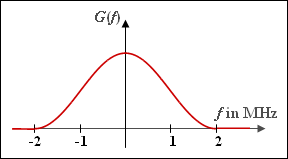Exercise 1.5: Cosine-Square Spectrum
The spectrum $G(f)$ with $\cos^{2}$–shaped course is considered according to the sketch. This satisfies the first Nyquist criterion:
- $$\sum_{k = -\infty}^{+\infty} G(f -{k}/{T} ) = {\rm const.}$$
Accordingly, the associated pulse $g(t)$ has zero crossings at multiples of $T$, where $T$ remains to be determined. The inverse Fourier transform of $G(f)$ yields the equation for the time course:
- $$g( t )= g_0 \cdot \frac{\cos(\pi \cdot t/T)}{1 - (2 \cdot t/T)^2}\cdot {\rm sinc}( {t}/{T})\hspace{0.05cm}.$$
The questions for this exercise refer to the following properties:
- The spectral function $G(f)$ is a special case of the cosine rolloff spectrum, which is point symmetric about the Nyquist frequency $f_{\rm Nyq}$.
- The cosine rolloff spectrum is completely characterized by the corner frequencies $f_{1}$ and $f_{2}$.
- For $| f | < f_{1}$, $G(f) = g_{0} \cdot T = \rm const.$, while the spectrum for $| f | > f_{2}$ has no components.
- The relation between the Nyquist frequency and the corner frequencies is:
- $$f_{\rm Nyq}= \frac{f_1 +f_2 } {2 }\hspace{0.05cm}.$$
- The edge steepness is characterized by the so-called rolloff factor:
- $$r = \frac{f_2 -f_1 } {f_2 +f_1 }\hspace{0.2cm}(0 \le r \le 1) \hspace{0.05cm}.$$
Note: The exercise belongs to the chapter "Properties of Nyquist Systems".
Questions
Solution
(2) From the given equations we obtain:
- $$f_{\rm Nyq} = \ \frac{f_1 +f_2 } {2 }\hspace{0.1cm}\underline { = 1\,{\rm MHz}}\hspace{0.05cm},\hspace{0.5cm} r = \ \frac{f_2 -f_1 } {f_2 +f_1 }\hspace{0.1cm}\underline { = 1 }\hspace{0.05cm}.$$
(3) The spacing of equidistant zero crossings is directly related to the Nyquist frequency:
- $$f_{\rm Nyq}= \frac{1}{2T} \hspace{0.3cm} \Rightarrow \hspace{0.3cm} T= \frac{1}{2f_{\rm Nyq}}\hspace{0.1cm}\underline { = 0.5\,{\rm µ s}}\hspace{0.05cm}.$$
(4) Statements 1 and 3 are correct:
- The first statement is correct: The function ${\rm sinc}(t/T)$ leads to zero crossings at $\nu T (\nu \neq 0)$.
- The last statement is also true: Because of $g(t) = 0$ for $t =\pm 1.5T, \pm 2.5T, \pm 3.5T, ...$ the second Nyquist criterion is also fulfilled.
- On the other hand, the middle statement is false, since $g(t = T/2) \neq 0$.
- The condition for the second Nyquist criterion is in the frequency domain:
- $$G_{\rm Per}(f) = \sum_{k = -\infty}^{+\infty} \frac {G \left ( f - {k}/{T} \right)}{\cos(\pi \cdot f \cdot T - k \cdot \pi)}= {\rm const.}$$
- The condition is indeed fulfilled for the cos$^{2}$–spectrum, as can be shown after a longer calculation.
- We restrict ourselves here to the frequency range $| f · T | \leq 1$ and set $g_{0} \cdot T = 1$ for simplicity:
- $$G_{\rm Per}(f) = \frac {\cos^2 \left [\pi/2 \cdot ( f_{\rm Nyq} - f) \cdot T \right ]}{\cos \left [\pi \cdot ( f_{\rm Nyq} - f) \cdot T \right ]}+\frac {\cos^2 \left [\pi/2 \cdot ( f_{\rm Nyq} + f) \cdot T \right ]}{\cos \left [\pi \cdot ( f_{\rm Nyq} + f) \cdot T \right ]}\hspace{0.05cm}.$$
- Further holds:
- $$\frac {\cos^2 (x)}{\cos(2x)} = {1}/{2} \cdot \frac {1+\cos(2x)}{\cos(2x)}= {1}/{2} \cdot \left [1+ \frac {1}{\cos(2x)}\right ]$$
- $$\Rightarrow \hspace{0.3cm} G_{\rm Per}(f) = {1}/{2} \cdot \left [1+ \frac {1}{\cos \left [\pi \cdot ( f_{\rm Nyq} - f) \cdot T \right ]} +1- \frac {1}{\cos \left [\pi \cdot ( f_{\rm Nyq} + f) \cdot T \right ]}\right ]\hspace{0.05cm}.$$
- Because of $\cos \left [ \pi \cdot ( f_{\rm Nyq} \pm f) \cdot T \right] = \cos \left ( {\pi}/{2} \pm \pi f T \right) = \sin \left ( \pm \pi f T \right)\text{:}$
- $$\Rightarrow \hspace{0.3cm} G_{\rm Per}(f) = 2 - \frac {1}{\sin (\pi f T)} + \frac {1}{\sin (\pi f T)} = 2 = {\rm const}\hspace{0.05cm}.$$
(5) For $t = T/2$, the given equation yields an indeterminate value ("0 divided by 0"), which can be determined using l'Hospital's rule.
- To do this, form the derivatives of the numerator and denominator and insert the desired time $t = T/2$ into the result:
- $$\frac{g( t = T/2)}{g_0} = \ {{\rm sinc}( \frac{t}{T}) \cdot \frac{{\rm d}/{\rm d}t \left [ \cos(\pi \cdot t/T)\right]}{{\rm d}/{\rm d}t\left [ 1 - (2 \cdot t/T)^2\right]}} \bigg |_{t = T/2} = \ {{\rm sinc}( \frac{t}{T}) \cdot \frac{- \pi/T \cdot \sin(\pi \cdot t/T)}{-2 \cdot (2\cdot t/T) \cdot (2/T)}} \bigg |_{t = T/2} = \frac {2}{\pi}\cdot \frac {\pi}{4}\hspace{0.1cm}\underline { = 0.5}\hspace{0.05cm}.$$
- A second solution method leads to the expression:
- $$\frac{g( t )}{g_0} = {\rm sinc}( \frac{t}{T}) \cdot \frac {\pi}{4} \cdot \big [ {\rm sinc}( t/T + 1/2) + {\rm sinc}(t/T - 1/2)\big] \hspace{0.05cm}.$$
- The second bracket expression can be transformed as follows:
- $$\frac {\pi}{4} \cdot \bigg [ \hspace{0.1cm}... \hspace{0.1cm} \bigg ] = \ \frac {\pi}{4} \cdot \left [ \frac {{\rm sin}(\pi \cdot t/T + \pi/2)}{\pi \cdot t/T + \pi/2} + \frac {{\rm sin}(\pi \cdot t/T - \pi/2)}{\pi \cdot t/T - \pi/2}\right] = \ \frac {1}{2} \cdot {\rm cos}(\pi \cdot t/T )\cdot \left [ \frac {1}{2 \cdot t/T + 1} - \frac {1}{ 2 \cdot t/T - 1}\right] $$
- $$\Rightarrow \hspace{0.3cm} \frac {\pi}{4} \cdot \bigg [ \hspace{0.1cm}... \hspace{0.1cm} \bigg ] = \ \frac {1}{2} \cdot {\rm cos}(\pi \cdot t/T )\cdot \frac{1- 2 \cdot t/T + 1+ 2 \cdot t/T}{(1+ 2 \cdot t/T)(1- 2 \cdot t/T)}= \frac{\cos(\pi \cdot t/T)}{1 - (2 \cdot t/T)^2}\hspace{0.05cm}.$$
- It follows that both expressions are actually equal. Thus, for time $t = T/2$, the following is still true:
- $$\frac{g( t = T/2)}{g_0} = {\rm sinc}( 0.5) \cdot \frac {\pi}{4} \cdot \big [ {\rm sinc}(1 ) + {\rm sinc}(0)\big]= \frac {2}{\pi}\cdot \frac {\pi}{4} = 0.5 \hspace{0.05cm}.$$
